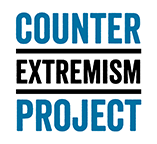Counter Extremism Project
 | |
| Formation | September 22, 2014 |
|---|---|
| Type | NGO |
| Legal status | 501(c)(3) nonprofit organization |
| Purpose | Combat extremist groups |
CEO | Mark Wallace |
President | Frances Townsend |
Executive Director | David Ibsen |
| Website |
www |
The Counter Extremism Project (CEP) is a nonprofit NGO that combats extremist groups "by pressuring financial support networks, countering the narrative of extremists and their online recruitment, and advocating for strong laws, policies and regulations."[1]
Overview
CEP was formally launched on September 22, 2014 by top former government officials, including former Homeland Security adviser Frances Townsend, former Connecticut Senator Joseph Lieberman, and Mark Wallace, a former U.S. Ambassador to the United Nations. The mission of the organization is to fight global extremism, with an initial goal of disrupting the financing and online recruitment and propaganda of the Islamic State of Iraq and the Levant.[2] The group is modeled on United Against Nuclear Iran, an advocacy group led by Wallace which has had success in contributing to the economic pressure on the Islamic Republic of Iran.[3] Other prominent board members include Gary Samore, August Hanning, Dennis Ross, and Irwin Cotler.[4]
Digital Disruption Campaign
CEP launched its "Digital Disruption Campaign" to remove accounts associated with ISIS from social media networks in order to deny them popular platforms to incite violence, spread their message, and recruit members. The campaign has particularly focused on Twitter, calling on the company to adopt new policies to prevent extremists such as ISIS from misusing their platform, as well as identifying ISIS accounts and alerting Twitter to remove them.[5][6][7][8][9] The campaign has led to death threats such as beheading against CEP President Fran Townsend on Twitter from jihadist accounts.[10]
Global Youth Summit Against Violent Extremism
On September 28, 2015, CEP co-hosted the first Global Youth Summit Against Violent Extremism with the U.S. Department of State and Search for Common Ground at The Roosevelt Hotel in New York City.[11] The event "drew more than 80 youth leaders from 45 countries with the objective of developing outreach and social-media intervention initiatives that can be shared globally."[12] Senior U.S. government officials who addressed the attendees included U.S. Homeland Security Advisor Lisa Monaco, Under Secretary of State for Public Diplomacy and Public Affairs Richard Stengel, and Under Secretary of State for Civilian Security, Democracy, and Human Rights Sarah Sewall.[13] The summit also featured presentations from Facebook and Microsoft.[14][15] A panel of judges at the summit awarded $100,000 to youth activist programs it believed would have the greatest impact.[14]
NORex
In June 2016, CEP unveiled a software tool for use by Internet and social media companies to "quickly find and eliminate extremist content used to spread and incite violence and attacks." CEP Senior Advisor Hany Farid, a Dartmouth college computer scientist, developed the software. It functions similarly to PhotoDNA, a system that uses robust hashing technology Farid worked on developing with Microsoft, which is "now widely used by Internet companies to stop the spread of content showing sexual exploitation or pornography involving children."[16][17][18]
To operationalize this new technology to combat extremism, CEP proposed the creation of a National Office for Reporting Extremism (NORex), which would house a comprehensive database of extremist content and function similar to the National Center for Missing & Exploited Children (NCMEC). The White House has signaled its support for this initiative. Lisa Monaco, President Obama’s top counterterrorism adviser, said, "We welcome the launch of initiatives such as the Counter Extremism Project’s National Office for Reporting Extremism (NORex) that enables companies to address terrorist activity on their platforms and better respond to the threat posed by terrorists’ activities online."[19][20] Wallace stated that if this system were to be adopted by social media companies and the private sector, it "would go a long way to making sure than online extremist is no longer pervasive."[16]
References
- ↑ "About". Counter Extremism Project.
- ↑ "Government Veterans to Take Fight to Extremists on Online Battleground". TIME. 22 September 2014.
- ↑ "New group plans to spotlight secret funding for Islamic State militants". The Washington Post. 20 September 2014.
- ↑ "Backers of anti-Iran group create mirror group against violent Islamists". JTA. 22 September 2014.
- ↑ "Digital Disruption Campaign". Counter Extremism Project.
- ↑ "Twitter pressed to confront terrorist abuse". The Washington Examiner. 6 February 2015.
- ↑ "Turns Out It's Pretty Hard To Shut Down Jihadi Twitter". BuzzFeed. 6 November 2014.
- ↑ "Terrorists on Twitter". Yahoo News. 16 November 2014.
- ↑ "There Are No 'Terms of Service' In War". Mother Jones. 8 December 2014.
- ↑ "Extremists plot assassinations of former U.S. national security officials". WTOP. 6 December 2014.
- ↑ "State Department to Co-Host Global Youth Summit Against Violent Extremism". U.S. State Department. September 25, 2015.
- ↑ "UN leaders agree on how to defeat ISIS. Doing it is the hard part". Christian Science Monitor. September 29, 2015.
- ↑ "CEP Hosts Global Youth Summit Against Violent Extremism". Counter Extremism Project. October 6, 2015.
- 1 2 "Steering Youth Away From Extremism Has $100,000 Prize at Summit". Bloomberg News. September 25, 2015.
- ↑ "Microsoft Corp. & Facebook to Lead Tech Discussion at Global Youth Summit Against Violent Extremism". Counter Extremism Project. September 25, 2015.
- 1 2 "Software unveiled to tackle online extremism, violence". AFP. June 17, 2016.
- ↑ "A Tool to Delete Beheading Videos Before They Even Appear Online". The Atlantic. June 22, 2016.
- ↑ "Suppressing Extremist Speech: There's an Algorithm for That!". Foreign Policy. June 17, 2016.
- ↑ "There's a new tool to take down terrorism images online. But social-media companies are wary of it.". The Washington Post. June 21, 2016.
- ↑ "How to Stop the Next Viral Jihadi Video". Defense One. June 17, 2016.